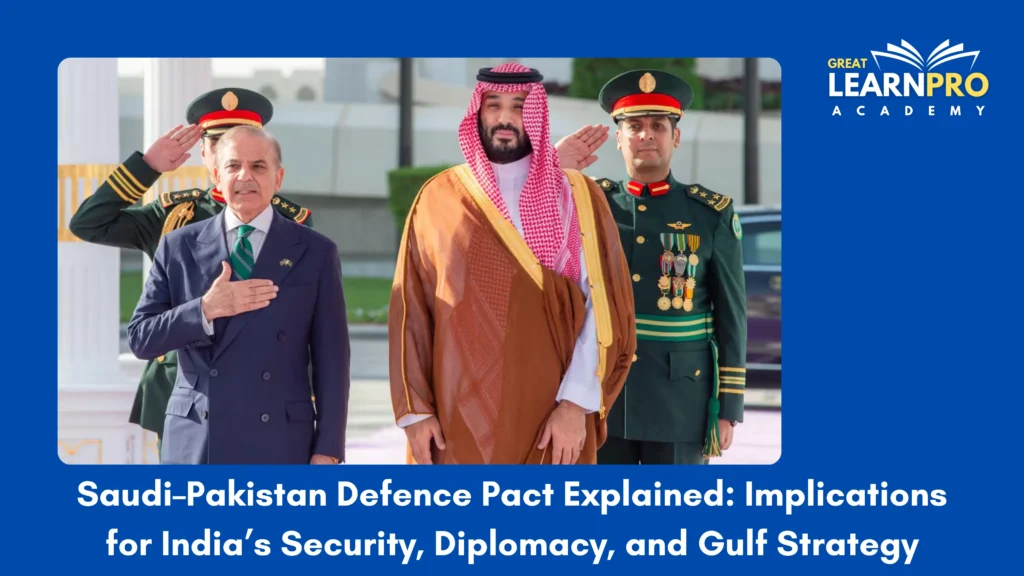On 17 September 2025 Saudi Arabia and Pakistan signed a “Strategic Mutual Defence Agreement” in Riyadh, pledging that an attack on either country would be treated as an attack on both and promising expanded defence cooperation across training, intelligence, procurement and deterrence. The headline that drew global attention was the pact’s potential to place Pakistan the regions only declared nuclear-armed state outside the five nuclear-weapon states at the centre of an extended-security arrangement for the Gulf. Public reporting indicates the agreement is broad and hortatory rather than an instant military union: it commits the partners to “develop aspects of defence cooperation” and treat aggression against one as aggression against both, and references cooperation in military industries and capacity-building. Riyadh has been careful not to say the pact is an explicit nuclear guarantee, but some Saudi statements and opacity in the text have prompted speculation about whether Pakistan’s deterrent could be invoked as an “umbrella.” Analysts warn against treating the document as a binding NATO-style guarantee; much will depend on implementing arrangements and political will.

Why this matters to India — quick framework
Three channels matter for New Delhi: strategic deterrence and nuclear signalling; balance of power and regional alignments in South Asia and the Gulf; and practical security and economic fallout (trade, diaspora issues, energy ties). Each channel interacts with India’s long-term interests: stable energy supplies, limiting adversarial coalitions, and preventing spillover of conflict into India’s neighbourhood.
Deterrence, signaling and nuclear concerns
If the pact is read by regional actors as extending Pakistan’s deterrent to Saudi soil, it would shift the signalling calculus in two ways. First, it could strengthen Riyadh’s sense of strategic autonomy from Washington by providing an alternative security assurance. Second, any credible linkage between Pakistan’s arsenal and Gulf security would complicate crisis stability raising questions about command, control, and thresholds for escalation that could reverberate in South Asia. For India the key worry isn’t immediate military confrontation but the normalization of extended deterrence arrangements that blur geographic limits of nuclear doctrines, complicating crisis management and raising the political cost of any coercive options. That said, several analysts caution the pact’s practical nuclear implications are likely limited absent formal, transparent arrangements.
Regional alignments and India’s diplomatic space
The pact signals shifting Gulf priorities: Riyadh is diversifying security partnerships amid doubts about the exclusivity of U.S. guarantees. For India this presents both challenge and opportunity. A closer Saudi–Pakistan axis could reduce New Delhi’s room to court both Riyadh and Islamabad simultaneously on sensitive issues; Saudi tilt toward Pakistan might harden Islamabad’s bargaining position on Kashmir-related diplomatic campaigns in the Islamic world. Conversely, India’s expanding bilateral ties with Gulf states energy, trade, large diasporas, and defence cooperation with countries such as the UAE and Saudi Arabia itself mean New Delhi still enjoys substantial leverage and should press for de-escalatory, institutional confidence-building measures in the region.
Practical security and economic spillovers
Short-term fallout may include shifts in military exercises, deeper Saudi-Pakistani defence industry ties, and intensified diplomatic activity across capitals (Washington, Beijing, Tehran, and Delhi). India will watch Pakistan’s force posture and any basing or logistics arrangements carefully. On the economic front, markets react to perceived instability although many commentators argue the pact’s real-world effects will be modest unless followed by concrete force deployments or basing agreements. India’s longer-term strategy ought to prioritize energy security diversification, bolstering maritime awareness in the Arabian Sea, and reinforcing deterrence and counter-coercion measures along its western approaches.
What India can do — policy options
- Reassure Gulf partners of Delhi’s reliability: deepen bilateral security and economic ties with Riyadh and other Gulf states to prevent Pakistan from monopolizing influence.
- Enhance maritime and intelligence cooperation in the Arabian Sea to reduce strategic surprises.
- Step up diplomatic outreach in multilateral forums to shape norms limiting extended nuclear entanglements and emphasize transparency in any arrangements that could affect regional stability.
- Continue calibrated deterrence measures along its western flank while avoiding escalatory rhetoric.
Bottom line
The Saudi–Pakistan defence pact is strategically consequential mainly for what it signals: Gulf states hedging beyond Washington, Pakistan regaining a high-value patron, and a potential re-framing of deterrence questions that now cross South Asian and Middle Eastern fault lines. For India the immediate practical impact may be limited if the pact remains declaratory, but the political and strategic ripple effects in diplomacy, crisis stability, and regional alignments merit a careful, calibrated Indian response that preserves ties with Gulf partners while shoring up security along the western approaches.
Sources:
- https://www.reuters.com/world/asia-pacific/saudi-arabia-nuclear-armed-pakistan-sign-mutual-defence-pact-2025-09-17/?utm_
- https://www.ndtv.com/opinion/the-saudi-pakistan-defence-pact-is-really-about-something-else-9390781?utm_
- https://m.economictimes.com/news/defence/if-more-nations-join-saudi-pakistan-defence-pact-it-will-become-nato-like-alliance-ishaq-dar/articleshow/124294941.cms?utm_
- https://www.scmp.com/week-asia/politics/article/3327211/pakistan-saudi-arabia-defence-pact-tests-indias-gulf-outreach?utm_
More Current affairs: https://learnproacademy.in/updates/
